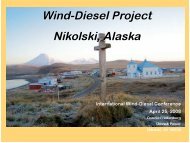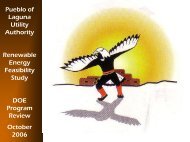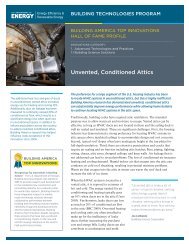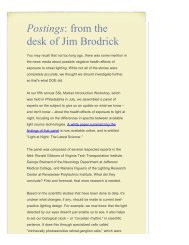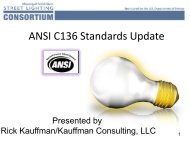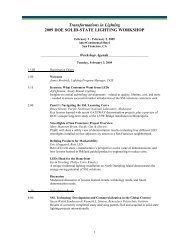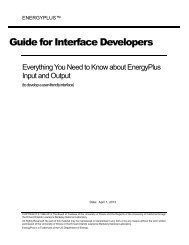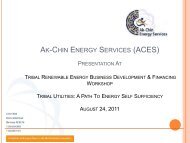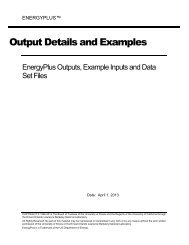EEBA Water Management Guide - EERE - U.S. Department of Energy
EEBA Water Management Guide - EERE - U.S. Department of Energy
EEBA Water Management Guide - EERE - U.S. Department of Energy
Create successful ePaper yourself
Turn your PDF publications into a flip-book with our unique Google optimized e-Paper software.
The <strong>Water</strong> <strong>Management</strong> <strong>Guide</strong> provides<br />
builders with practical advice for keeping<br />
buildings dry by keeping out rain water<br />
and ground water.<br />
The DOE-sponsored <strong>Water</strong> <strong>Management</strong><br />
<strong>Guide</strong> has brought critical attention to<br />
one <strong>of</strong> the most critical durability issues<br />
associated with high-performance homes.<br />
The <strong>Water</strong> <strong>Management</strong> <strong>Guide</strong> has sold<br />
15,000 copies since its first printing.<br />
BUILDING AMERICA<br />
TOP INNOVATIONS<br />
Recognizing Top Innovations in Building<br />
Science – The U.S. <strong>Department</strong> <strong>of</strong> <strong>Energy</strong>’s<br />
Building America program was started in<br />
1995 to provide research and development<br />
to the residential new construction and<br />
remodeling industry. As a national center<br />
for world-class research, Building America<br />
funds integrated research in marketready<br />
technology solutions through<br />
collaborative partnerships between<br />
building and remodeling industry leaders,<br />
nationally recognized building scientists,<br />
and the national laboratories. Building<br />
America Top Innovation Awards recognize<br />
those projects that have had a pr<strong>of</strong>ound<br />
or transforming impact on the new and<br />
retr<strong>of</strong>it housing industries on the road to<br />
high-performance homes.<br />
BUILDING TECHNOLOGIES PROGRAM<br />
BUILDING AMERICA TOP INNOVATIONS<br />
HALL OF FAME PROFILE<br />
INNOVATIONS CATEGORY:<br />
3. Effective Guidance and Tools Solutions<br />
3.1 High-Performance Home Solutions<br />
<strong>EEBA</strong> <strong>Water</strong><br />
<strong>Management</strong> <strong>Guide</strong><br />
As energy codes and voluntary programs such as ENERGY STAR for Homes and<br />
the DOE Challenge Home continue transforming the housing industry to high<br />
performance, better insulated and air-sealed assemblies now have substantially<br />
reduced tolerance for drying. As a result, managing bulk water flow has become<br />
critical to durable construction. The DOE-sponsored <strong>Water</strong> Mangement <strong>Guide</strong> has<br />
proven to be a highly effective tool for disseminating much needed best practices.<br />
The U.S. <strong>Department</strong> <strong>of</strong> <strong>Energy</strong>’s Building America program sponsored<br />
development <strong>of</strong> the <strong>Water</strong> <strong>Management</strong> <strong>Guide</strong>, written by Joe Lstiburek, a<br />
building scientist and principal with Building America research partner, Building<br />
Science Corporation. The guide gives builders practical guidance for minimizing<br />
moisture problems in homes by controlling the entry <strong>of</strong> rain water and ground<br />
water. The guide was published by <strong>EEBA</strong> (the <strong>Energy</strong> & Environmental Building<br />
Alliance) in 2006 and is available through <strong>EEBA</strong>’s online store, www.eeba.org/<br />
bookstore/prod-<strong>Water</strong>_<strong>Management</strong>_<strong>Guide</strong>-9.aspx.<br />
Controlling rain and ground water are among the most important factors in the<br />
design and construction <strong>of</strong> durable homes. They also contribute to healthy homes<br />
since mold problems cannot exist without moisture. If you can eliminate water<br />
problems, you can reduce the likelihood <strong>of</strong> mold problems.<br />
The <strong>Water</strong> <strong>Management</strong> <strong>Guide</strong> presents a variety <strong>of</strong> recommendations for<br />
minimizing water intrusion into homes. The guide includes dozens <strong>of</strong> drawings<br />
illustrating techniques for constructing ro<strong>of</strong>, wall, window, and foundation<br />
assemblies to minimize the entry <strong>of</strong> liquid water. The guide recognizes that almost<br />
no cladding system is 100% foolpro<strong>of</strong> 100% <strong>of</strong> the time. So, assemblies must also<br />
be designed to allow water out <strong>of</strong> the structure if it does get in and to provide<br />
drying potential for building components in the event that they do get wet.<br />
The <strong>Water</strong> <strong>Management</strong> <strong>Guide</strong> includes guidance on<br />
• fundamental principles <strong>of</strong> water management<br />
• draining the site and the foundation<br />
• draining ro<strong>of</strong> and wall assemblies including screen and barrier assemblies<br />
• draining wall and window openings<br />
• draining materials.
BUILDING AMERICA TOP INNOVATIONS HALL OF FAME PROFILE<br />
The guide was preceded by other handbooks on moisture developed by<br />
Joe Lstiburek with sponsorship from DOE. This includes Moisture Control<br />
Handbook: Principles and Practices for Residential and Small Commercial<br />
Buildings by Joseph Lstiburek and John Carmody <strong>of</strong> the University <strong>of</strong><br />
Minnesota, published in 1994 by John Wiley and Sons. This handbook was<br />
a major revision <strong>of</strong> an earlier book, also called Moisture Control Handbook,<br />
also written by Lstiburek with DOE sponsorship.<br />
The <strong>Water</strong> <strong>Management</strong> <strong>Guide</strong> addresses water in the liquid form—rain<br />
water and ground water. Research and guidance for builders on ways to deal<br />
with water in the vapor form, transported by either air flow or diffusion,<br />
are discussed in other DOE-sponsored publications including the Building<br />
America Best Practices <strong>Guide</strong>s, the Attic Air Sealing <strong>Guide</strong> by Building Science<br />
Corporation, and the Ventilation <strong>Guide</strong> by Building Science Corporation,<br />
as well as numerous articles on Building America team websites.<br />
Drain all water away from the structure<br />
The secret to water management is to construct the site and building assemblies<br />
to allow all water to drain down, out, and away from the structure.<br />
Drain Wall<br />
Drain Site<br />
Drain Building<br />
Drain Materials<br />
Drain Components<br />
Drain Openings<br />
Drain Ro<strong>of</strong><br />
Drain Site<br />
DOE Building Technologies Program<br />
www.buildings.gov<br />
Building America Solutions Center<br />
www.buildingamerica.gov/solutionscenter<br />
PNNL-SA-90564 January 2013<br />
Building America sponsored development<br />
<strong>of</strong> the Ventilation <strong>Guide</strong> authored by<br />
Building Science Corporation’s Armin<br />
Rudd in 2006 and revised in 2011.<br />
REFERENCES<br />
Baechler, MC et al. 2009-12. Builders Challenge<br />
<strong>Guide</strong> to 40% Whole-House <strong>Energy</strong> Savings in<br />
the Hot-Dry and Mixed Dry, Cold, Marine, Marine,<br />
Hot-Humid, and Mixed Humid Climates, Volumes<br />
9, 11, 12, 15, and 16, Prepared by Pacific Northwest<br />
National Laboratory for the U.S. <strong>Department</strong> <strong>of</strong><br />
<strong>Energy</strong>, www.buildingamerica.gov.<br />
Lstiburek, J. 2010. <strong>Guide</strong> to Attic Air<br />
Sealing. Building Science Corporation. www.<br />
buildingscience.com/documents/guides-andmanuals/gm-attic-air-sealing-guide/view.<br />
Lstiburek, J. 2006. <strong>Water</strong> <strong>Management</strong> <strong>Guide</strong>,<br />
the <strong>Energy</strong> & Environmental Building Alliance,<br />
www.eeba.org/bookstore/prod-<strong>Water</strong>_<br />
<strong>Management</strong>_<strong>Guide</strong>-9.aspx<br />
Rudd, A. 2011. Ventilation <strong>Guide</strong>, Building Science<br />
Press, http://www.eeba.org/bookstore/prod-<br />
Ventilation_<strong>Guide</strong>-10.aspx.<br />
www.BuildingAmerica.gov



